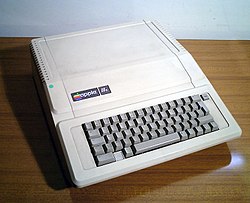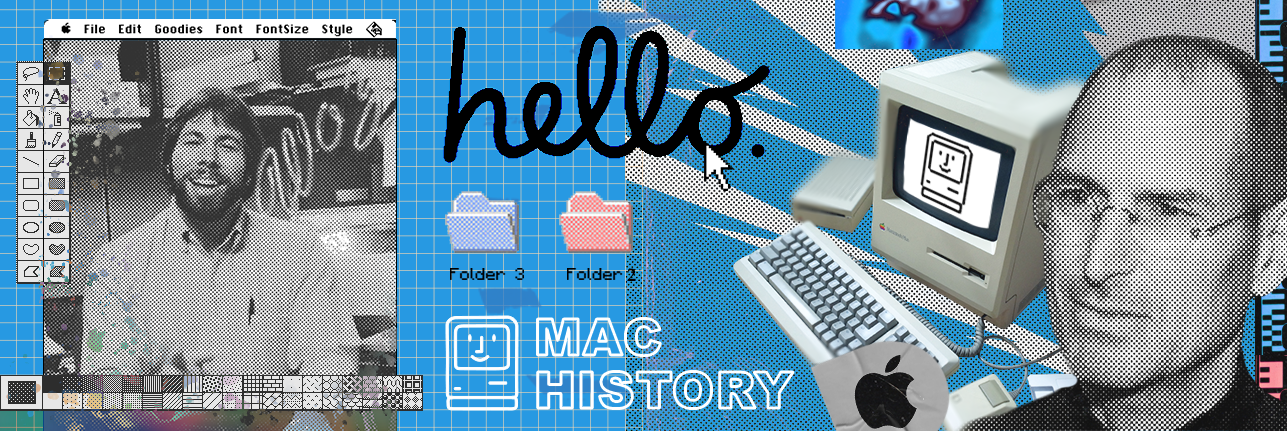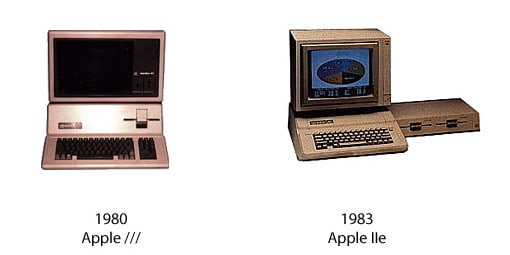Apple III
 |
|
| Manufacturer | Apple Computer |
|---|---|
| Introduced | May 1980 |
| Discontinued | April 1984 |
| Price | US$7,800[1] |
| CPU | Synertek 6502A, 2 MHz |
| RAM | 128 KB, expandable to 512 KB, |
| OS | Apple Sophisticated OS (SOS) |
The Apple III (often rendered as Apple ///) was a personal computer aimed at business users, manufactured and sold by Apple from May, 1980 until its discontinuation on April 24, 1984. Its predecessor, the better-known Apple II, was designed by Apple co-founder Steve Wozniak. Design work on the Apple III started in late 1978 under the guidance of Dr. Wendell Sander. It had the internal code name of “Sara”, named after Sander’s daughter.
The Apple III was designed to be a business computer and a successor for the Apple II . It featured an advanced operating system called SOS (the Sophisticated Operating System) and a new BASIC interpreter, “Apple /// Business BASIC” (an implementation of UCSD Pascal was also offered for more structured programming). Other features included an 80-column display with upper and lowercase characters, a numeric keypad, support for a real-time clock, 6-bit (DAC) audio, 16-color graphics, a hierarchical file system. It included a built-in 140 KB 5.25″ floppy disk drive, with up to three additional external “Disk ///” floppy disk drives, which were only compatible with the Apple ///. In addition they required an adapter for use on the /// Plus.
Originally intended as a direct replacement to the Apple II series, it was designed for backwards-compatibility of Apple II software in order to migrate users over. However, since Apple did not want to encourage continued development of the II platform, they limited its capabilities to emulate a basic 48 KB Apple II+ configuration, with no access to the III’s advanced features, a restriction which actually required custom chips to enforce.
The Apple III was powered by a 2 MHz SynerTek 6502A 8-bit CPU and, like some of the more advanced machines in the Apple II family, used bank switching techniques to address up to 256 KB of memory (512 KB with a third-party upgrade).
The Apple III was the first Apple product that allowed the user to choose both a screen font and a keyboard layout:either QWERTY or Dvorak. These choices could not be changed while programs were running, unlike the Apple IIc, which had a keyboard switch directly above the keyboard, allowing switching on the fly.
The Apple III had a System Utilities program, which allowed system reconfiguration and file manipulation. Another program, Selector III, was designed to integrate with the System Utilities program and launch various applications. However, Apple decided not to finish this project, and the engineers and writers working on the project bought the right to market Selector III to Apple III owners for a nominal fee. However, another company, Quark Software, developed a competing product, Catalyst, the cruder interface of which was offset by program-switching capabilities and support for copy-protection, which enabled companies to license users to run programs from a hard disk without worrying that their software might be backed up or copied without permission. When Apple decided to bundle Catalyst with its new ProFile hard disk, Quark celebrated—it eventually grew into a major software vendor with QuarkXPress); and the Selector III’s developers quietly dissolved their company.
One popular anecdote about the Apple III is probably better remembered than the machine itself: in a technical bulletin, customers who were experiencing certain problems were instructed to lift the machine 3 inches (76 mm) and drop it in order to reseat the chips. Another problem was that the circuit board used a “fineline” technology that was not fully mature, with narrow, closely spaced traces. When chips were “stuffed” into the board and wave-soldered, solder bridges would form between traces that were not supposed to be connected. This caused numerous short circuits, which required hours of costly diagnosis and hand rework to fix. Apple designed a new circuit board, with more layers and normal-width traces. It was designed by one designer on a huge drafting board, rather than a costly CAD-CAM system used for the previous board, and it worked.
Some of the features and codebase of the Sophisticated Operating System made their way into the Apple II’s ProDOS and GS/OS operating systems, as well as those of the Lisa and Macintosh.
Commercial failure
For a variety of reasons, the Apple III was a commercial failure. With a starting price between $4,340 to $7,800 US, it was more expensive than many of the CP/M-based business computers that were available at the time.[1] The Apple III’s software library was very limited, and whilst sold as an Apple II compatible, the emulation that made this possible was intentionally hobbled, thus it could not make use of the advanced III features (specifically 64 KB RAM or higher, required by a large number of Apple II software titles based on PASCAL), which limited its usefulness.
Far more importantly, the machine was plagued by numerous hardware and software bugs. The real time clock, the first in an Apple computer, would fail after prolonged use. This chip, which was made by National Semiconductor, was an example of a recurrent problem. Semiconductor purchase contracts allowed a vendor 30 days to replace defective parts. It was assumed that a vendor would test parts before shipping them, but this was not required. National had a reputation for knowingly shipping bad parts, confident that they could do another production run before they had to send replacements. This was not a problem for customers who put chips in sockets and had extensive repair facilities. However, Apple was soldering chips directly to boards and could not easily test a board to find a single bad chip. Eventually, Apple solved this problem by deleting the real-time clock from the specification, rather than putting in a working clock chip.
Other widely experienced problems were due to the fact that the Apple III had no cooling fan (as suggested by Steve Jobs for quieter performance) or air vents. Because of this many Apple III computers were manufactured with heatsinks, but since the system had a metal case and chips crammed together with no air vents, it was impossible for enough heat to escape. Some users said that their Apple III became so hot that the chips started dislodging from the board, the screen would display garbled data, or their disk would come out of the slot “melted” (which was another reason why there are very few Apple IIIs left).
In the end, Apple had to replace the first 14,000 Apple III machines, free of charge. The customers who had bought them were given brand new machines, with new circuit boards. These did not constitute a new model: it was deemed warranty service. However for new customers in late 1981 it was a newly revised system, with twice as much memory (256K RAM) and sold for a much lower introductory price of $3,495. At the same time, Apple also introduced the optional ProFile 5 MB external hard drive.
Apple III Plus
An improved version, the Apple III Plus, was introduced in December 1983 and sold for $2,995 US. The III Plus fixed the hardware problems of the original III, included 256 KB RAM, built-in clock, video interlacing, and featured a keyboard in the style of the Apple IIe. However, not even the new “allow me to reintroduce myself” campaign could salvage the III’s reputation. Possibly more relevant in the long run was the fact that the III was essentially an enhanced Apple II—newest heir to a line of 8-bit machines dating back to 1976. The year after the III was originally released, IBM unveiled its PC—a completely new 16-bit design soon available in a wide range of inexpensive clones. The business market moved rapidly towards the IBM machines and, in September 1985, the Apple III line was discontinued, having sold only about 65,000 systems. Apple co-founder Steve Wozniak stated that the primary reason for the Apple III’s failure was that the system was designed by Apple’s marketing department, unlike Apple’s previous engineering-driven projects.
References
Apple III chaos (Cortland),LEM Staff, Low End Mac (2006)
External links
The Ill-Fated Apple III
Many manuals and diagrams
Source:
Apple III. (2008, August 19). In Wikipedia, The Free Encyclopedia. Retrieved 13:18, September 14, 2008, from http://en.wikipedia.org/w/index.php?title=Apple_III&oldid=232808671
Apple IIe
 |
|
| Apple IIe | |
|---|---|
| Manufacturer | Apple Computer |
| Introduced | January 1983 |
| Discontinued | November 1993 |
| Price | US$1298 |
| CPU | 6502 / 65C02, 1.023 MHz |
| RAM | 64 KB (up to 1 MB+), |
| OS | ProDOS |
The Apple IIe is the third model in the Apple II series of personal computers produced by Apple Computer. The e in the name stands for enhanced, referring to the fact that several popular features were now built-in that were only available as upgrades and add-ons in earlier models. It also improved upon expandability and added a few new features, which, all combined, made it very attractive to first-time computer shoppers as a general-purpose machine. The Apple IIe has the distinction of being the longest-lived computer in Apple’s history, having been manufactured and sold for nearly 11 years with relatively few changes. For this reason, it is the most commonly recognized model in the Apple II line.
The beginning
Apple had planned to retire the Apple II series after the introduction of the Apple III in 1980, however, after that machine turned out to be a disastrous failure, management decided the further continuation of the Apple II was in the company’s best interest. So, after three and a half years at a stand-still, came the introduction of a new Apple II model—the Apple IIe (codenamed: “Diana” and “Super II”). The Apple IIe was released in January 1983, the successor to the Apple II Plus. Some of the hardware and software features of the Apple III were borrowed in the design of the Apple IIe. The culmination of these changes led to increased sales and greater market share of both home and small business use.
Overview of new features
One of the most notable improvements of the Apple IIe is the addition of a full ASCII character set and keyboard. The most important addition is the ability to input and display lower-case letters. Other keyboard improvements include four-way directional cursor control and standard editing keys (Delete and Tab), two special Apple modifier keys (Open and Solid Apple), and a safe off-to-side relocation of the “Reset” key. The auto-repeat function (any key held down to repeat same character continuously) is now automatic, no longer requiring the “REPT” key (now gone) found on the previous model’s keyboard.
The machine came standard with 64 KB RAM, with the equivalent of a built-in Apple Language Card in its circuitry, and had a new special “Auxiliary slot” (replacing slot-0, though electronically mapped to slot-3 for compatibility with earlier third-party 80 column cards) for adding more memory via bank-switching RAM cards. Through this slot it also includes built-in support for an 80 columns text display on monitors (with the addition of a plug-in 1K memory card, via bank-switching of 40 columns) and could be easily doubled to 128 KB RAM by alternatively plugging in an Apple’s Extended 80 Columns Card. As time progressed even more memory could be added through third party cards using the same bank-switching slot, or alternatively general purpose slot cards that addressed memory 1 byte at a time (i.e. Slinky RAM cards). A new ROM diagnostic routine could be invoked to test the motherboard for faults and its main bank of memory.
The Apple IIe lowered production costs and improved reliability by merging the function of several off-the-shelf ICs into single custom chips, reducing total chip count to 31 (previous models used 120 chips). For this reason the motherboard design is much cleaner and runs cooler as well, with enough room to add a pin-connector for an (optional) external numeric keypad. Also added was a backport accessible DE-9 joystick connector, making it far easier for users to add and remove game and input devices (previous models requiring plugging the joystick/paddles directly into a 16-pin DIP socket on the motherboard; the IIe retained this connector for backwards compatibility). Also improved were port openings for expansion cards. Rather than cutout V-shaped slot openings as in the Apple II and II Plus, the IIe has a variety of different sized openings, with thumb-screw holes, to accommodate mounting interface cards with DB-xx and DE-xx connectors (removable plastic covers filled the cutouts if not used). The Apple IIe maintains full backwards compatibility with the previous two Apple II models, allowing most hardware and software from those systems to be used.
Technical specifications
Microprocessor
- 6502 or 65C02 running at 1.023 MHz
- 8-bit data bus
Memory
- 64 KB RAM built-in
- 16 KB ROM built-in
- Expandable from 64 KB up to 1 MB RAM or more
Video modes
- 40 and 80 columns text, white-on-black, with 24 lines¹
- Low-Resolution: 40×48 (16 colors)
- High-Resolution: 280×192 (6 colors) *
- Double-Low-Resolution: 80×48 (16 colors)
- Double-High-Resolution: 560×192 (16 colors) *
*effectively 140×192 in color, due to pixel placement restrictions
¹Text can be mixed with graphic modes, replacing either bottom 8 or 32 lines of graphics with 4 lines of text, depending on video mode
Audio
- Built-in speaker; 1-bit toggling
- Built-in cassette recorder interface; 1-bit toggle output, 1-bit zero-crossing input
Expansion
- Seven Apple II Bus slots (50-pin card-edge)
- Auxiliary slot (60-pin card-edge)
Internal connectors
- Game I/O socket (16-pin DIP)
- RF modulation output (4-pin Molex)
- Numeric keypad (11-pin Molex)
External connectors
- NTSC composite video output (RCA connector)
- Cassette in/out (two 1/8″ mono phono jacks)
- Joystick (DE-9)
In production from January 1983 until November 1993, the Apple IIe remained relatively unchanged through the years. However there was one significant motherboard update, a major firmware update, two cosmetically revised machines and an official compatible from Apple, in the form of slot card for the Macintosh computer. These revisions are detailed below.
The Revision A motherboard
At the time of the Apple IIe’s introduction, and well into the first few months of production, this motherboard shipped with all units. Graphics modes supported are identical, and limited to, that of the Apple II Plus before it. The logic board is not compatible with the ROM based firmware update (introduced some years later) and most newer plug in expansion slot cards.
The Revision B motherboard
Shortly after the “Revision A” motherboard’s release in 1983, engineers discovered that the bank-switching feature (which used a paralleled 64 KB of RAM on the Extended 80 Columns Card; or 1 KB to produce 80 columns using bank-switching) could also be used to produce a new graphics mode, Double-High-Resolution, with double the horizontal resolution and number of colors of standard High-Resolution. In order to support this, some modifications had to be made to the motherboard, which became the Revision B. In addition to supporting Double-High-Resolution and Double-Low-Resolution (see list above) it also added a special video signal accessible in slot-7.
Apple upgraded the motherboard free of charge. In later years Apple labeled newer IIe motherboards with a “-A” suffix once again, although in functionality they were Revision B motherboards.
New case and keyboard
In 1984, Apple revised the case and keyboard. The original IIe uses a case very similar to the Apple II Plus, painted and with Velcro-type clips to secure the lid with a strip of metal mesh along the edge to eliminate Radio Frequency Interference. The new case is made of dyed plastic mold in a slightly darker beige with a simplified snap-case lid. The other noticeable change is a new keyboard, with more professional looking print on darker keycaps (small black lettering, versus large white print). This was the first cosmetic change.
International versions
The Apple IIe keyboard differed depending on what region of the world it was sold in. Sometimes the differences were very minor, such as extra local language characters and symbols printed on certain keycaps (e.g. French accented characters on Canadian IIe such as “á”, “é”, “ç”, etc, or the British Pound “£” symbol on the UK IIe) while other times the layout and shape of keys greatly differed (e.g. European IIe). In order to access the local character set and keyboard layout, a user-accessible switch is found on the underside of the keyboard — flipping it will instantly switch the video output and keyboard input from the US character set to the local set. To support this, special double capacity video and keyboard ROMs are used; in early motherboards they had to reside on a tiny circuit card that plugged into the socket. In some countries these localized IIe’s also support 50 Hz PAL video instead of the standard 60 Hz NTSC video and the different 220/240 volt power of that region. An equivalent of the “PAL color card” for the earlier Apple II europlus model was integrated into the motherboard of these IIe’s, so that color graphics are available without the addition of a slot card.
Another difference with the European IIe, is the Auxiliary slot physically moved in location so it is in line and in front of slot-3, preventing both slots from being used simultaneously for full-sized cards. A few third-party cards are affected by this: some European cards that plug into both slots simultaneously and are thus unusable on American IIe’s, and some American cards that don’t fit into the case of European IIe’s because the European location of the Auxiliary slot leaves less room for them.


